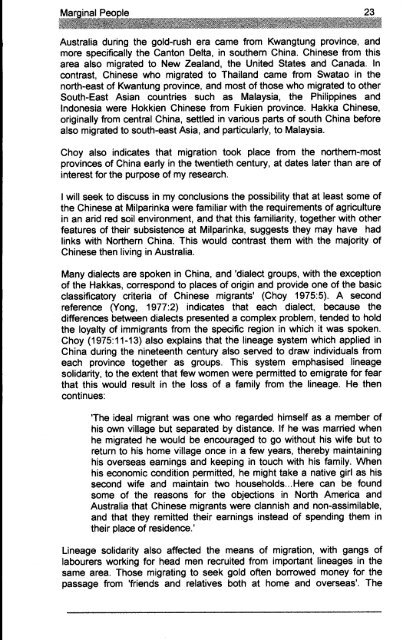Adec Preview Generated PDF File - The Sydney eScholarship ...
Adec Preview Generated PDF File - The Sydney eScholarship ...
Adec Preview Generated PDF File - The Sydney eScholarship ...
You also want an ePaper? Increase the reach of your titles
YUMPU automatically turns print PDFs into web optimized ePapers that Google loves.
Australia during the gold-rush era came from Kwangtung province, and<br />
more specifically the Canton Delta, in southern China. Chinese from this<br />
area also migrated to New Zealand, the United States and Canada. In<br />
contrast, Chinese who migrated to Thailand came from Swatao in the<br />
north-east of Kwantung province, and most of those who migrated to other<br />
South-East Asian countries such as Malaysia, the Philippines and<br />
Indonesia were Hokkien Chinese from Fukien province. Hakka Chinese,<br />
originally from central China, settled in various parts of south China before<br />
also migrated to south-east Asia, and particularly, to Malaysia.<br />
Choy also indicates that migration took place from the northern-most<br />
provinces of China early in the twentieth century, at dates later than are of<br />
interest for the purpose of my research.<br />
I will seek to discuss in my conclusions the possibility that at least some of<br />
the Chinese at Milparinka were familiar with the requirements of agriculture<br />
in an arid red soil environment, and that this familiarity, together with other<br />
features of their subsistence at Milparinka, suggests they may have had<br />
links with Northern China. This would contrast them with the majority of<br />
Chinese then living in Australia.<br />
Many dialects are spoken in China, and 'dialect groups, with the exception<br />
of the Hakkas, correspond to places of origin and prOVide one of the basic<br />
c1assificatory criteria of Chinese migrants' (Choy 1975:5). A second<br />
reference (Yong, 1977:2) indicates that each dialect, because the<br />
differences between dialects presented a complex problem, tended to hold<br />
the loyalty of immigrants from the specific region in which it was spoken.<br />
Choy (1975:11-13) also explains that the lineage system which applied in<br />
China during the nineteenth century also served to draw individuals from<br />
each province together as groups. This system emphasised lineage<br />
solidarity, to the extent that few women were permitted to emigrate for fear<br />
that this would result in the loss of a family from the lineage. He then<br />
continues:<br />
'<strong>The</strong> ideal migrant was one who regarded himself as a member of<br />
his own village but separated by distance. If he was married when<br />
he migrated he would be encouraged to go without his wife but to<br />
return to his home village once in a few years, thereby maintaining<br />
his overseas earnings and keeping in touch with his family. When<br />
his economic condition permitted, he might take a native girl as his<br />
second wife and maintain two households... Here can be found<br />
some of the reasons for the objections in North America and<br />
Australia that Chinese migrants were clannish and non-assimilable,<br />
and that they remitted their earnings instead of spending them in<br />
their place of residence. '<br />
Lineage solidarity also affected the means of migration, with gangs of<br />
labourers working for head men recruited from important lineages in the<br />
same area. Those migrating to seek gold often borrowed money for the<br />
passage from 'friends and relatives both at home and overseas'. <strong>The</strong>




